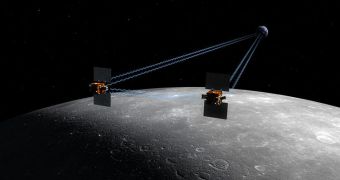Officials with the American space agency say that the twin Gravity Recovery And Interior Laboratory (GRAIL) lunar probes are ready for their scheduled launch date, on Thursday, September 8. The mission is meant to decipher the riddles the Moon's interior still poses.
One of the primary science objectives of the new mission is to map the gravitational field surrounding Earth's natural satellite in unprecedented detail. This will give researchers the opportunity to understand how the Moon formed in the early days of the solar system.
GRAIL will take off from the Cape Canaveral Air Force Station's (CCAFS) Space Launch Complex 17B (SLC-17B), aboard a Delta II 7920H-10 delivery system. The spacecraft are scheduled to begin their actual science mission as early as March 2012.
According to experts, there are only two, 1-second launch windows available for the day, at 8:37 am and 9:16 am EDT (1237 and 1337 GMT), respectively. If they manage to take advantage of these opportunities, then GRAIL will reach the Moon around New Year's Day, Space reports.
The principal investigator of the GRAIL mission, Massachusetts Institute of Technology (MIT) expert Maria Zuber, says that the spacecraft will “reveal clues not only into the history of the moon and Earth, but will provide important data for future lunar exploration.”
Usually, when an orbiter is placed on a direct orbit to the Moon, it takes about 3 days to get there. However, the $496-million mission was kept at such a low cost by taking on a different type of route.
NASA selected an orbit that will take the two space probes through the Sun-Earth Lagrange Point 1. This means that they will need about three-and-a-half months to reach their destination. By doing so, mission controllers managed to preserve large amounts of fuel.
At this point, plans call for introducing GRAIL into a 34-mile (55-kilometer) polar orbit around Earth's satellite. This is the same type of orbit used for weather studies and espionage around our planet.
As they travel on their determined paths, the two spacecraft will be tugged slightly away or towards each other, depending on the regional differences in the Moon's gravitational field. By constantly measuring the distance between them, they will, in effect, measure the gravitational field in detail.
If the Delta II rocket cannot take off on Thursday, then NASA will still be left with numerous opportunities to launch GRAIL. The overall launch window ends on October 19, which means that the space agency will have more than 5 weeks at its disposal.

 14 DAY TRIAL //
14 DAY TRIAL //